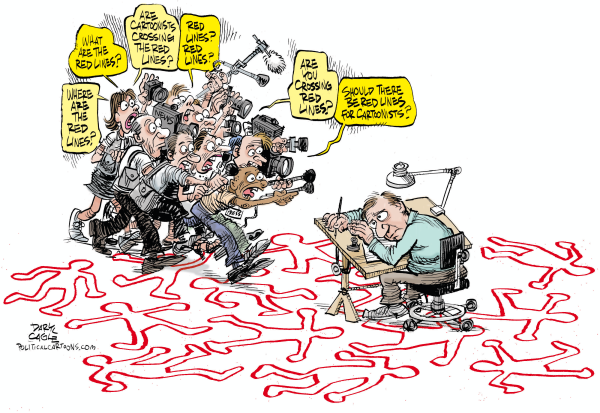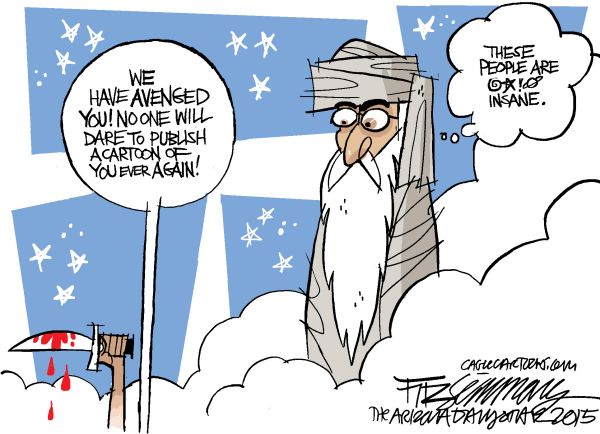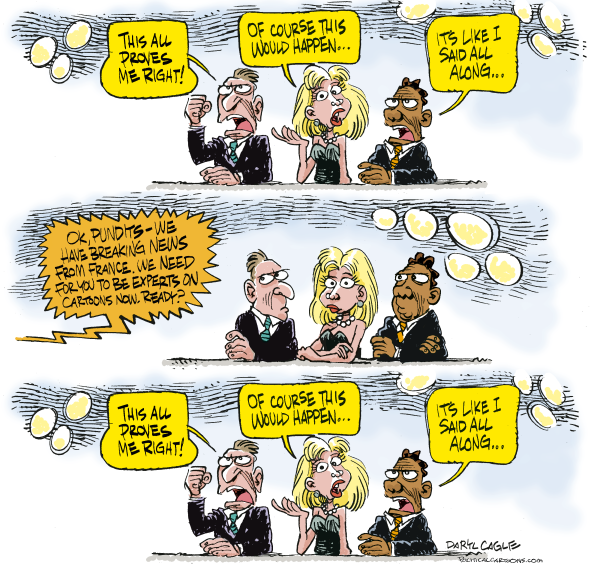
Freedom of Expression


Like blaming a rape victim for her “provocative dress,” many press pundits blame the Charlie Hebdo cartoonists (and the Danish cartoonists before them) for crossing “red lines,” and inviting trouble. In the past few days the small community of American editorial cartoonists have been getting calls from their local media, asking for comments about self-censorship and what subjects we should be forbidden to draw in a free society.
Political cartoonists have no clear red lines, but we are certainly censored. Cartoonists are a macho bunch; we want to draw provocative cartoons, bashing the reader on the head with the most powerful images possible. Editors see cartoonists as bomb throwers, to be reigned in.
There are about fifteen-hundred daily, paid circulation newspapers in America, and less than fifty cartoonists have jobs working for those papers, the vast majority of the papers use “syndicated” cartoons, culling a cartoon or two each day from a large menu of available, national cartoon options. Newspaper editors have been growing more timid, wanting to avoid reprinting anything that might offend a declining readership; they usually avoid printing the most hard-hitting cartoons. The result is that American editorial cartoons are tame compared to cartoons around the world – and in France.
 Yesterday, one of the cartoonists I syndicate, David Fitzsimmons of The Arizona Daily Star in Tucson, drew a cartoon depicting the Prophet Muhammad that we delivered to our 850 subscribing newspapers. Editorial cartoons depicting the Prophet Muhammad are not unusual. We were flooded with calls from editors questioning our wisdom in posting the cartoon, and asking if other editors were running it before deciding to run it themselves.
Yesterday, one of the cartoonists I syndicate, David Fitzsimmons of The Arizona Daily Star in Tucson, drew a cartoon depicting the Prophet Muhammad that we delivered to our 850 subscribing newspapers. Editorial cartoons depicting the Prophet Muhammad are not unusual. We were flooded with calls from editors questioning our wisdom in posting the cartoon, and asking if other editors were running it before deciding to run it themselves.
Cartoons are more powerful than words. Readers don’t cut columns out of the newspaper to hang on their fridges. Editors quickly learn that cartoons generate more angry e-mail than the same ideas expressed in words. Editors prefer cartoons that are like Jay Leno jokes, about a topic in the news, but expressing no real opinion. If we want our work to be reprinted, cartoonists have to consider drawings that timid editorial-gatekeepers will let pass. This is the censorship of the marketplace.
I know cartoonists who insist on drawing offensive cartoons with four letter words; they complain that the market is unfair for rejecting them. Tame cartoonists are sometimes derided by our macho colleagues for selling-out to syndication. My French cartoonist friends joke about American cartoonists being prudes. For example, the French draw bare breasts in their cartoons frequently; American cartoonists can’t do that if they want their cartoons to be reprinted in U.S. newspapers -a bare-breasted fact that amuses my French colleagues.
Our censorship of the marketplace in a free society is nothing like government censorship, a concept that is difficult for the much of the world to understand or appreciate. Around the world editorial cartooning is a dangerous profession, and censorship is real. Cartoonists in China self-censor, never drawing the Chinese president; cartoonists in Cuba have never drawn Fidel Castro. Our cartoonists in Singapore tell me they can draw whatever they want, as long as it isn’t about Singapore. Government censorship is so common around the world that calls for red lines seem reasonable to many.
Editorial cartoons are more important around the world than they are in America. Charlie Hebdo is a top magazine in France; it is on newsstands everywhere; the top French cartoonists vie to be on the pages of Charlie Hebdo and a second, satirical paper, Le Canard Enchainé (the “Unchained Duck”). Sadly, there are no similar publications on American newsstands. Visitors to Cairo are greeted by dozens of newspapers, most with editorial cartoons on the front page. Editorial cartooning has a much stronger tradition in the romance language and Arabic speaking countries where editorial cartoonists are among the most influential voices in society. It is no surprise that editorial cartoons are the flashpoint of a clash of civilizations.
The calls for cartoonists to self-censor are absurd. In a free society we will always have a broad range of voices. Extremist cartoonists are effectively censored when there are no publications willing to convey their rants – and no audiences who want to see their offensive work. Cartoonists are constantly pushing the limits, with editors guarding the red lines, pushing back.
In France, the heroic Charlie Hebdo cartoonists lampooned issues that are important to their French audience, with Muslim extremists at the top of their lampoon-list. Cartoonists respond to intolerance with ridicule. Typically, timid editors respond to intolerance with too much restraint.
There should be no “red lines,” just good judgment. Editors should show more bravery. The cartoonists are already brave; we need more editors who cover our backs.
Stop asking cartoonists about red lines. Ask editors about red lines. Ask the editors to be more brave.

My Heroes and their Posters
I’ve gotten to know the French political cartoonists through two groups, Cartooning for Peace, which is a great organization run by France’s star cartoonist, Plantu, who draws for the Le Monde (the World) newspaper – and the Salon International de la Caricature, du Design de Presse et d’humous, the annual editorial cartoonists convention in the little village of St. Just le Martel.
I’ve written here before about the convention, and winning the cow, their grand prize. Three of the four cartoonists who were murdered at the Charlie Hebdo offices also did posters for St Just (I didn’t meet the fourth killed, cartoonist/editor/publisher Charb) but I knew the other three, and here are their posters …

This first poster is by Coco, a charming cartoonist I’ve met at a number of functions over the years. She survived the attack with injuries and was released from the hospital. She was at the offices with her young daughter and was described as a receptionist in initial reports. Coco is great fun and a great talent. My thoughts and prayers are with her at this difficult time.

Many French cartoonists, and cartoonists around the world, choose to draw under a single pen name – a single name like Cher, Beyonce, Maverick, Superman, Flipper, Lassie – its just a thing they do. They call me “Cagle” and call each other by their one name, so I’m going with that here. The next two posters are by Tignous, a cartoonist that I met at a number of events and I had a lot of time to chat with him. He was a great guy, and he leaves four kids behind. Very sad. He was charming, brave and witty – he bashed Muslim extremists mercilessly in his edgy work … and he drew lots of bare breasts, something that makes life worthwhile.


The next two are by Cabu, who I only met briefly. He had a major exhibition of his work at St. Just in 2013 and was a popular guy.


The next one is by Georges Wolinski, who looked and acted much younger than his 80 years; I had lots of opportunities to chat with him in recent years at conventions. He was charming and was a gentleman who drew in a loose, swishy and wordy style (French cartoonists can be quite wordy). Here’s Wolinski’s poster. He drew lots of bawdy, sexy stuff, more common to the French cartoonists, who think we Americans are prudish.

The winner of the Humor Vache cow is expected to draw the poster for the St. Just Salon the following year, here’s my poster.
These are dark days, but the French cartoonists are talented and principled. I have no doubt that they will bounce back, more acerbic than ever.
Charlie Hebdo TV Pundits

The Media and Red Lines

With Our Love to Charlie Hebdo

Cartoonist Head Reposted

I woke up this morning to the news of the terrorist attack on the Charlie Hebdo Magazine office in Paris. Twelve people were killed and eleven wounded, including two of my French cartoonist friends, Tignous and Wolinski. Cartoonists around the world are grieving.
Americans treat editorial cartoons as a trivial daily joke in the newspaper – in France, editorial cartoons and loved and respected. The Louvre has a branch museum devoted to cartoons; imagine if the Smithsonian had a cartoon museum, that’s the way cartoons are revered in France.

“Charlie Hebdo” is a silly name; it is a weekly magazine filled with editorial cartoons, easily found on news stands everywhere in France. “Hebdo” means “weekly” in French, and “Charlie” comes from France’s love for the comic strip “Peanuts” and Charlie Brown – therefore “Charlie Hebdo.” The top cartoonists in France vie to be on the pages of Charlie Hebdo.
There are cartoon festivals all over France – the best one for political cartoonists is in the small town of St Just le Martel; I’ve been attending for years, along with other cartoonists I syndicate. The townspeople pitch in to throw a festival for the editorial cartoonists every year; villagers put cartoonists up in their homes, and they award a live cow to the “Humor Vache” cartoonist of the year. One greatly respected winner of the cow was Georges Wolinski, a brilliant cartoonist with a masterful loose, swishy, wordy style, highly respected by the French. We were fellow cow winners, having a beer together last October; it is hard to imagine that he is gone.
The Charlie Hebdo cartoonists are a diverse group of charming characters; they are the heart of the French cartooning community. There are not a lot of editorial cartoonists. We get to know each other; the murders are a blow that strikes close to all of us.
The Charlie Hebdo artists were energized and incensed by the Danish Muhammad cartoon fracas a few years ago. French cartoonists have a macho attitude, seeing themselves on the front lines of a free speech debate. One Charlie Hebdo issue, touted as “edited by the Profit Muhammad” had all blank pages. One Charlie Hebdo cover featured a drawing, by French cartoonist “Luz” of the magazine’s publisher/cartoonist “Charb” having a sloppy kiss with a Muslim Man, under the headline “L’Amour plus for que la haine” or “love is stronger than hate.” Charb was among those killed in the terror attack.
Terrorists have no sense of humor. Cartoons loom large in the Arab world, typically on the front pages of Arab language newspapers. It is no wonder that our cartoons seem to bother the terrorists more than our words. Sitting behind a beer with Charlie Hebdo cartoonists, the talk often turns to Islamic extremeists and their assaults on press freedoms. No one can doubt that editorial cartoonists are leading the fight for press freedoms now.
Today we are are grieving, but as we move forward, I hope that our cartoons won’t be chilled by these murders and that the cartooning community will step up to this challenge with even more brilliant and insightful work – I’m sure the French cartoonists will do that; they are my heroes.

Cartoon Jihads Reposted

Muhammad Descending a Staircase Reposted

Dropping Oil Prices Impact Stock Market
















